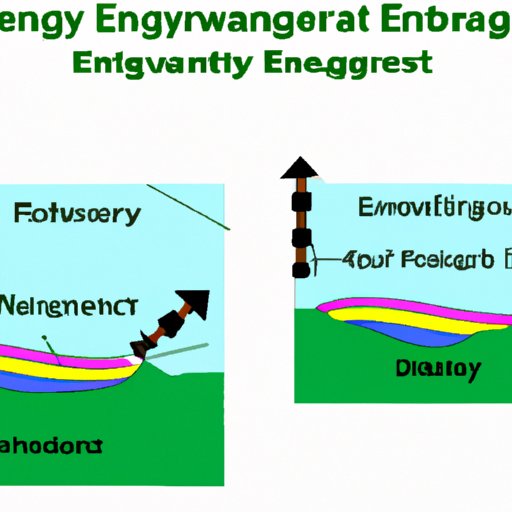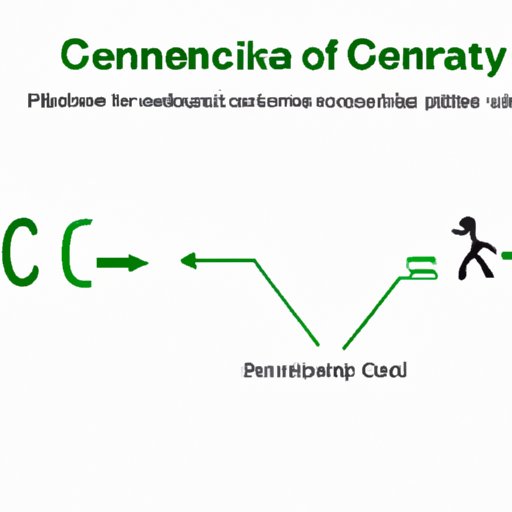
I. Introduction
Potential energy is a fundamental concept in physics, engineering, and everyday life. Put simply, it is the energy stored within an object based on its position or condition. Understanding potential energy is essential in various fields, from designing roller coasters to harnessing renewable energy sources.
A. Definition of Potential Energy
Potential energy is defined as the energy that an object possesses due to its position relative to a position of zero potential energy. Typically, this position is the height at which an object will not move due to gravitational force. The higher the object is, the more potential energy it has.
B. Explanation of How It Works
To understand the basic principles of potential energy, you need to look at the relationship between gravitational force and an object’s mass and height. The formula for potential energy is: PE=mgh, where m is the mass of the object, g is the acceleration due to gravity, and h is the height of the object. Essentially, the object stores energy until it is released and transformed into kinetic energy.

C. Importance of Understanding Potential Energy
Understanding potential energy is essential in various fields, including physics, engineering, and renewable energy. It is also important to have some familiarity with potential energy to become aware of the ways it is working in different aspects of daily life.
II. Methods of Calculating Potential Energy
A. Gravitational Potential Energy Equation
The gravitational potential energy equation is used to calculate potential energy due to gravity. The formula is: PE=mgh.
1. Explanation of the Formula
The formula is composed of three variables. The mass, m, is the amount of matter in the object, measured in kilograms. The acceleration due to gravity, g, is the amount of force applied by gravity to every kilogram of mass, measured in meters per second squared. The height, h, is the distance from the object to the ground, measured in meters. Using these values, you can determine the amount of potential energy that the object has due to gravity.
2. Example of How to Use the Formula
To illustrate the calculation of gravitational potential energy, consider a basketball that weighs 0.625 kilograms and is held 4 meters off the ground. The gravitational potential energy can be found by using the formula: PE = mgh.
PE = 0.625 kg x 9.8 m/s² x 4 m = 24.5 J
B. Elastic Potential Energy Equation
Elastic potential energy is stored energy that is held within a stretched or compressed elastic object. Examples can include springs and rubber bands. The formula for elastic potential energy is: PE=(1/2)kb^2.
1. Explanation of the Formula
The formula uses two variables. The spring constant, k, which is measured in newtons per meter and indicates how much force is required to stretch a spring, and the deformation distance or compression, b, which is measured in meters and indicates the distance the spring, for example, is stretched.
2. Example of How to Use the Formula
To calculate the elastic potential energy, the spring constant and the stretch/compression of the spring must be known. Consider a spring with a spring constant of 10 N/m that is stretched 2 meters. The elastic potential energy can be found by using the formula: PE=(1/2)kb^2.
PE = (1/2)(10 N/m)(2 m)² = 20 J
III. Real-World Applications of Potential Energy
A. Hydroelectric Power Plants
Hydroelectric power plants generate electricity by transforming the gravitational potential energy of water in dams into kinetic energy. As the water flows down, it travels through a turbine connected to a generator. The speed of the turbine causes it to turn, and this movement generates electricity.
1. Explanation of How They Work
The basic process behind hydroelectric power involves using falling water to create a source of kinetic energy. The water is stored in a reservoir or dam above a turbine. Once released, the water travels through pipes to the turbine, causing it to turn. The movement of the turbine is then converted into electrical energy using a generator.
2. Example of How Potential Energy Is Used
The Hoover Dam, located on the Colorado River between Arizona and Nevada, is an excellent example of a hydroelectric power plant. The dam uses the gravitational potential energy of water to generate electricity. It has a total installed capacity of 2,080 MW, and its average annual output is 4.2 billion kWh.
B. Roller Coasters
Roller coasters are fun to ride and thrilling to watch, but have you ever thought about how they use potential energy? Roller coasters operate on the principle of potential energy conversion into kinetic energy.
1. Explanation of How They Use Potential Energy
Roller coasters start by using a lift hill, which is a mechanism that raises the coaster up to an elevated point. The higher the coaster’s starting height, the more potential energy it has. Once at the top, the coaster travels down a steep hill. During this descent, the potential energy of the coaster is transformed into kinetic energy: the energy of motion.
2. Example of How It Is Transformed into Kinetic Energy
An example of a famous roller coaster using potential energy is the Top Thrill Dragster located at Cedar Point amusement park in Ohio. It stands at 420 feet tall, making it the second-tallest coaster in the world. The coaster accelerates from 0 to 120 miles per hour in 3.8 seconds, thanks to the release of the potential energy towards kinetic energy.
C. Dam Systems
Dam systems are used both for controlling river levels and generating electricity. When water is stopped at a dam, it becomes potential energy, as it has the ability to push against the dam and create a force to generate electricity.
1. Explanation of How They Use Potential Energy
Dam systems use vast quantities of water to produce electricity. They store falling water and use it to spin turbines and generate electricity. The height of the water above the powerhouse determines the amount of gravitational potential energy, which is then released to generate hydroelectric power.
2. Example of How It Is Transformed into Electrical Energy
The Grand Coulee Dam, located on the Columbia River in the state of Washington, is the largest electric power station in the United States, generating up to 21 billion kilowatt-hours per year. The dam uses the potential energy of water to generate electrical energy, which is sent on to the Pacific Northwest’s electric grid.
IV. Experimenting with Potential Energy
A. Step-by-Step Guide on Conducting Experiments to Demonstrate Potential Energy
If you want to learn more about potential energy, there are several experiments you can do that are both safe and easy to set up. One experiment is rolling a ball down a ramp. Here’s how to do it.
1. Rolling a Ball Down a Ramp
Materials: a ramp made of cardboard or another smooth surface, a ball, measuring tape, and a weight scale.
Instructions:
- Place the ramp at a specific angle from the ground.
- Measure the height of the ramp above the ground, known as its elevation.
- Measure the mass of the ball.
- Release the ball down the ramp.
- Measure the distance the ball travels before stopping.
2. Calculating Potential Energy at Different Points
Using the measurements taken, calculate the potential energy the ball has at different points along the ramp. The formula to be used is: PE=mgh. Record the energy values and compare them against the initial values to learn about the ball’s potential energy changes during its progress down the ramp.
V. Relationship between Potential and Kinetic Energy
A. Explanation of the Relationship Between the Two
Potential and Kinetic Energy are both forms of energy of distinct types. Potential Energy is stored energy, and the kinetic energy of an object is the energy it possesses as a result of motion. The two are related by Force, which is equal to the change in kinetic energy or the gain in potential energy.
B. How They Work in Tandem
The relationship between potential and kinetic energy is crucial to understanding how objects move and behave. They work in tandem; potential energy is transformed into kinetic energy. So when an object falls from a height, potential energy is converted into kinetic energy, and when an object is lifted, kinetic energy is transformed into potential energy. This is a constant cycle, and the interplay between the two is critical in keeping things in motion.
C. Transformation of Potential Energy to Kinetic Energy
Motion is fueled by potential energy; the greater the potential energy, the greater the kinetic energy produced upon release that fuels the object’s motion. When the stored energy is released, it causes the object to move, and progressively, the released potential energy is transformed into kinetic energy as the object accelerates.
VI. Conclusion and Key Takeaways
A. Recap of Main Points
In conclusion, potential energy is the energy of an object stored as a result of its position or condition. Understanding potential energy is crucial in several fields, including physics, engineering, and renewable energy. The Gravitational potential energy equation and the Elastic potential energy equation are two methods of calculating potential energy. Potential energy is put to work in several applications such as Hydroelectric Power Plants, Roller Coasters, and Dam Systems. You can conduct experiments to learn more about potential energy. Potential and Kinetic Energy is related by the force, and motion is fueled by potential energy, which is progressively transformed into kinetic energy.
B. Emphasis on the Importance of Understanding Potential Energy
Potential energy is a fascinating concept, and understanding how it works can improve your understanding of the world around you. Understanding potential energy helps both academicians and professionals such as engineers and physicists to make informed decisions in scientific projects. Learning about potential energy will provide you with the foundation to gain a deep understanding of how energy works and how to harness it effectively.
C. Key Takeaways for Readers to Remember
- Potential energy is the energy stored in an object due to its position or condition.
- Gravitational potential energy Equation PE = mgh, Elastic potential energy equation PE =1/2 kb^2 are the two methods to calculate potential energy
- Potential energy is used for various applications such as Hydroelectric Power Plants, Roller Coasters, and Dam Systems.




